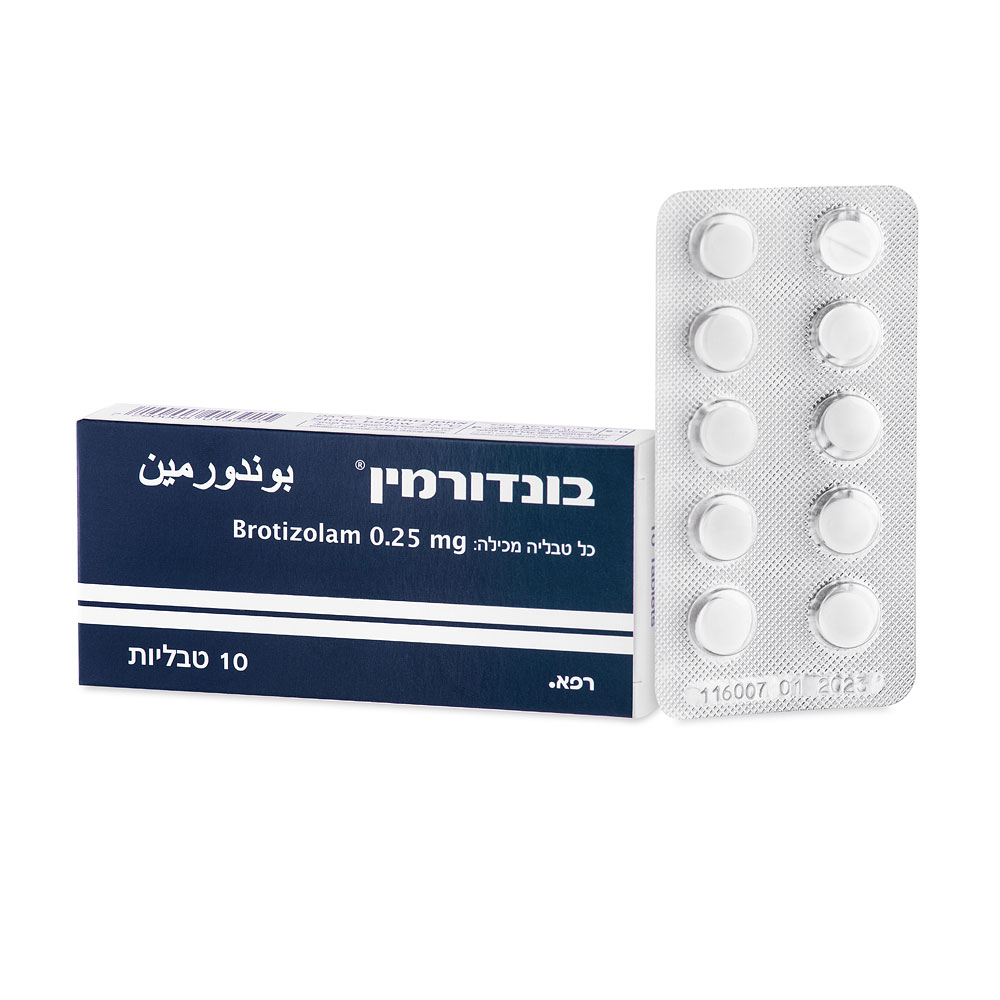Quest for the right Drug

בונדורמין BONDORMIN (BROTIZOLAM)
תרופה במרשם
תרופה בסל
נרקוטיקה
ציטוטוקסיקה
צורת מתן:
פומי : PER OS
צורת מינון:
טבליה : TABLETS
עלון לרופא
מינוניםPosology התוויות
Indications תופעות לוואי
Adverse reactions התוויות נגד
Contraindications אינטראקציות
Interactions מינון יתר
Overdose הריון/הנקה
Pregnancy & Lactation אוכלוסיות מיוחדות
Special populations תכונות פרמקולוגיות
Pharmacological properties מידע רוקחי
Pharmaceutical particulars אזהרת שימוש
Special Warning עלון לרופא
Physicians Leaflet
Pharmacological properties : תכונות פרמקולוגיות
Pharmacodynamic Properties
5.1 Pharmacodynamic properties Pharmacotherapeutic group: Hypnotics and sedatives, benzodiazepines ATC code: N05C D09 Brotizolam is a thienotriazolodiazepine derivative (hetrazepine), which binds specifically and with high affinity to benzodiazepine receptors in the CNS and which therefore exhibits the characteristic pharmacological properties of benzodiazepines. It shortens sleep onset time, reduces nocturnal awakenings and increases total sleep time. At the recommended doses, changes in sleep architecture occur; the electroencephalographic measurement (EEG) revealed that the mean duration and percentage of REM sleep were reduced during the first 6 hours of sleep. In addition to its hypnotic effects, brotizolam demonstrated anxiolytic, sedative and muscle relaxant effects in animal studies.
Pharmacokinetic Properties
5.2 Pharmacokinetic properties Absorption Following oral administration, brotizolam is rapidly absorbed from the gastro-intestinal tract. After a single oral dose of 0.25 mg, a mean peak plasma concentration of 5.5 ± 0.7 ng/ml is achieved within 45 ± 12 min. Absorption is an apparent first-order process with a mean half-life of 14.9 ± 8.5 min. Absolute bioavailability following oral administration is about 70%. Distribution Brotizolam is 89 - 95% bound to human plasma proteins and has an apparent distribution half-life of between 7 and 26 min. The areas under the plasma concentration-time curve (AUC) range from 31.0 ± 5.7 ng∙h/ml to 56.6 ± 21.3 ng∙h/ml. Brotizolam is well distributed throughout the human body; the mean apparent volume of distribution is about 0.66 l/kg. In animals, brotizolam crosses the placental barrier and is excreted in the milk. Biotransformation Brotizolam is metabolised in the liver by CYP 3A4-mediated oxidative reactions; hydroxylation at various sites on the molecule (the methyl group and the diazepine ring) is the preferred metabolic pathway. All the hydroxylated metabolites are virtually completely conjugated with glucuronic and/or sulphuric acid. These metabolites are less active than the parent compounds and it is assumed that they do not contribute to the clinical effect. Elimination Following oral administration of brotizolam, about two-thirds of a dose is excreted renally; the remainder is excreted via the faeces. Less than 1% of the dose is excreted in the urine as the parent compound. The major metabolites of brotizolam, -hydroxybrotizolam and 6-hydroxybrotizolam, can be detected in the urine at concentrations of 27% and 7% respectively. Other highly polar metabolites which are presumed to have more than one hydroxyl group, as well as a substance which is less polar than brotizolam, can also be detected in the urine. The mean elimination half-life of brotizolam from plasma is short and varies between 3 and 8 h in healthy subjects. Brotizolam has been classified as a short-acting benzodiazepine. The mean apparent oral clearance values for brotizolam following an oral dose of 0.25 mg range from 128.36 to 188.37 ml/min. The differences observed can be attributed to the methods of determination used (RIA and GLC). Repeated daily doses of 0.25 mg did not lead to accumulation or to any change in the pharmacokinetics of brotizolam compared to administration of a single dose. Special patient populations: Elderly Following oral administration of 0.25 mg, the mean time to peak plasma concentration was slightly higher in elderly patients (mean age 82 years) than in younger subjects (mean age 23 years) (1.7 h vs. 1.1 h). The mean peak concentration in elderly patients after an oral dose of 0.25 mg is about 5.6 ng/ ml, which is no different from the concentrations found in studies in young healthy subjects. The elimination half-life following oral administration is significantly longer in elderly patients than in young volunteers (9.1 h vs. 5.0 h; P < 0.02). The absolute bioavailability of brotizolam in elderly patients is about 66%. Following continuous administration of a 0.25-mg dose of brotizolam over three weeks, neither accumulation nor faster elimination was observed. The pharmacokinetics of brotizolam are linear up to a dose of 1.5 mg. Renal impairment The pharmacokinetics of brotizolam are essentially the same for all patients with renal impairment irrespective of their creatinine clearance values (< 15 ml/min, 15 - 45 ml/min or 45 - 80 ml/min). The mean plasma elimination half-lives for patients with mild, moderate and severe renal insufficiency were 8.15 h, 6.90 h and 7.6 h, respectively. Hepatic impairment In patients with hepatic cirrhosis, the peak absorption time and peak concentration of brotizolam are similar to those observed in healthy subjects, whilst the protein binding and clearance of unbound brotizolam are lower; the mean elimination half-life in patients with hepatic cirrhosis is 12.8 h (9.4 - 25 h). Alcohol Concurrent alcohol consumption significantly reduces the clearance of brotizolam (1.85 ml/min/kg vs. 2.19 ml/min/kg), increases peak plasma concentrations (5.3 ng/ml vs. 4.3 ng/ml) and prolongs the terminal elimination half-life (5.2 h vs. 4.4 h).

שימוש לפי פנקס קופ''ח כללית 1994
Insomnia
תאריך הכללה מקורי בסל
01/01/1995
הגבלות
תרופה שאושרה לשימוש כללי בקופ'ח
מידע נוסף
